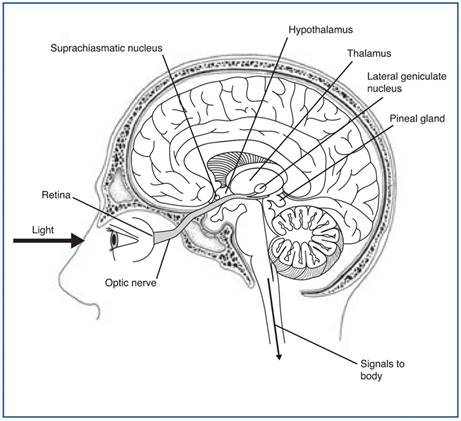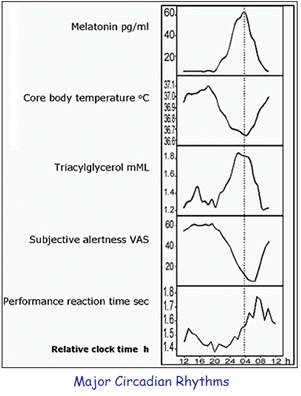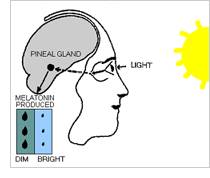
A biological clock is a time-keeping system that ensures our ability to adapt to and exist in harmony with the 24 day / night and seasonal changes of the earth. By generating 24 hour circadian rhythms in our body for hormonal release and cardiovascular, behavioral and other functions. The body contains several such clocks.
In humans (and other mammals), it is housed in the brain's hypothalamus. This is the master pacemaker of our body's circadian timekeeping system.
The SCN consists of a pair of pinhead-size regions. Each containing only about 10,000 neurons out of the brain's estimated 100 billion neurons.
The SCN receives information about environmental lighting. From the retina via optical nerves and indirect pathways, thus forming the main link between external and internal times.(There is also some evidence that the pineal gland may be able to directly sense the light).
Almost every physiological variable in living (and developing) organisms shows a circadian rhythm. Humans (and most vertebrates) have an internally generated rhythm with a period of slightly more than 24 hours - i.e. a true circadian rhythm.
The existence of a circadian or daily rhythm is apparent in physiological, pharmacological and pathological events - including:
Brandon DH, Holditch-Davis D, Belyea M. Preterm infants born at less than 31 weeks'gestation have improved growth in cycled light compared with continuous near darkness. J Pediatr. 2002 Feb;140(2):192-9. PubMed
Circadian rhythms are of two general types
(1) Exogenous circadian rhythms. Directly produced by an external influence, such as an environmental cue. E.g. Light entering eyes. Since it is not generated by the organism itself, if the environmental cues are removed, the rhythm ceases
(2) Endogenous circadian rhythms. Driven by an internal, self-sustaining biological clock rather than by anything external to the organism. E.g. cyclical changes in core body temperature are endogenous. They are maintained even if environmental cues are removed.

The endogenous circadian rhythm persists in the absence of time cues, but can be entrained (synchronized) to the 24-hour day:
Other factors involved in entrainment include:
MELATONIN
The circadian rhythms vary for different species
The most important function of these clocks is to regulate the biological rhythms in the 24 hour sleep/wake cycle:
The SCN ("Biological Clock") regulates MELATONIN production and release into bloodstream by being either ON or OFF - determined by the presence of light or darkness perceived by the eyes:

(1) Instructs a group of cells (the superior cervical ganglion) to make the chemical messenger NE, but it can not be released until . . .
(2) Darkness tells the "Biological Clock" to remove its blocking effect on the release of the chemical messenger NE. Thereby permitting the pineal gland to produce MELATONIN and secrete it into the bloodstream.
MELATONIN feeds back to the SCN to regulate its activity. Most of the brain receptors for MELATONIN are located in the SCN (in mammals)
MELATONIN supplementation:
Evidence that supplement MELATONIN promotes sleep is inconclusive
Seasonal Rhythms. In addition to synchronizing daily rhythms, biological clocks can affect rhythms that are longer than 24 hours, especially seasonal rhythms
Some vertebrate animals have reproductive systems that can sense day length by the amount of MELATONIN secreted:
The clock must be entrained, or reset, to match the day length of the environmental light / dark (i.e. day/night) cycle. Because the circadian clock in most humans has a natural, inherent day length of just over 24 hours,
The cue that synchronizes the internal biological clock to the environmental cycle is light. Photoreceptors in the retina transmit light-dependent signals to the SCN. Interestingly, our usual visual system receptors, the rods and cones, are apparently not required for this photoreception. Special types of retinal ganglion cells are photoreceptive, project directly to the SCN, and appear to have all the properties required to provide the light signals for synchronizing the master clock. At the SCN, the signal interacts with several genes that serve as "pacemakers."
Diagram shows a day-by-day representation of one individual's sleep/wake cycle

The dark gray lines indicate periods of sleep, and the light gray lines indicate periods of being awake
Days 1-9 represents this individual's normal sleep/wake cycle. Under these conditions, the individual is exposed to regularly timed exposure to alternating daylight and darkness, which has entrained this person's sleep/wake cycling to a period of 24 hours.
Days 10-34 this individual has been isolated from normal environmental cues like daylight, darkness, temperature variation, and noise variation
(a) This individual's sleep/wake cycle continues to oscillate in the absence of external cues, showing that this rhythm is endogenous, or built in.
(b) In the absence of external cues to entrain circadian rhythms, this individual's clock cycles with its own natural, built-in rhythm (just over 24 hours long) - Consequently, without environmental cues, the individual goes to bed about one hour later each night. After 24 days, the individual is once again going to bed at midnight, the time to which the SCN was previously entrained.
Jet lag. Results from the inability of our circadian clock to make an immediate adjustment to the changes in light cues that an individual experiences when rapidly crossing time zones. After such travel, the body is in conflict. The biological clock carries the rhythm entrained by the original time zone, even though the clock is out of step with the cues in the new time zone. This conflict between external and internal clocks and signals is called desynchronization.
| Discovery of Biological Clock |
|---|
| The 20th century saw the recognition that all living beings, including unicellular organisms, possess a biological clock system that measures time in near 24-h (circadian) units resulting in rhythmic patterns with a period of 24-h, termed circadian rhythms. The tendency of some organisms to sleep at night and some during the day, and the fact that some plants open their leaves during the day and close them at night, are common observations. The reasonable assumption that these are passive responses to the day/night changes in the environment was proven wrong by a simple yet brilliant experiment performed in the 18th century. In 1729, French astronomer Jean Jacques d'Ortous de Mairan showed that the upright movement of the leaves of the plant Mimosa pudica at nighttime and the opening of these leaves during the daytime hours continued over several days when the plant was maintained in constant darkness, indicating that the leaves'movement followed an endogenous 24-h clock. |